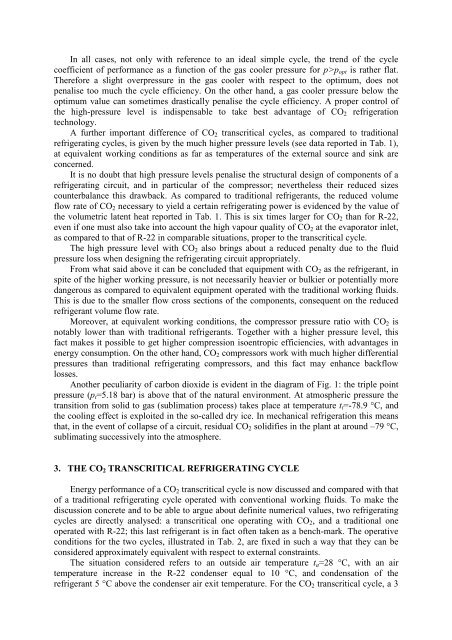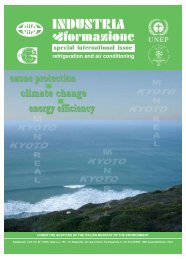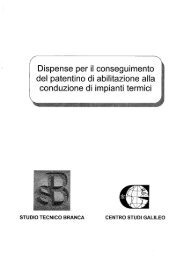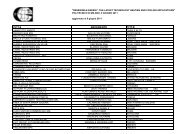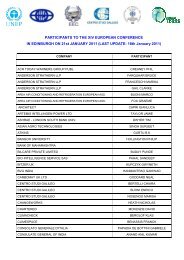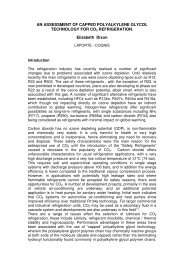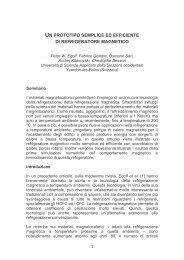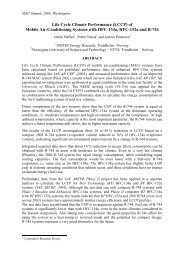PROPERTIES OF CO2 AS A REFRIGERANT - Centro Studi Galileo
PROPERTIES OF CO2 AS A REFRIGERANT - Centro Studi Galileo
PROPERTIES OF CO2 AS A REFRIGERANT - Centro Studi Galileo
Create successful ePaper yourself
Turn your PDF publications into a flip-book with our unique Google optimized e-Paper software.
In all cases, not only with reference to an ideal simple cycle, the trend of the cycle<br />
coefficient of performance as a function of the gas cooler pressure for p>p opt is rather flat.<br />
Therefore a slight overpressure in the gas cooler with respect to the optimum, does not<br />
penalise too much the cycle efficiency. On the other hand, a gas cooler pressure below the<br />
optimum value can sometimes drastically penalise the cycle efficiency. A proper control of<br />
the high-pressure level is indispensable to take best advantage of CO 2 refrigeration<br />
technology.<br />
A further important difference of CO 2 transcritical cycles, as compared to traditional<br />
refrigerating cycles, is given by the much higher pressure levels (see data reported in Tab. 1),<br />
at equivalent working conditions as far as temperatures of the external source and sink are<br />
concerned.<br />
It is no doubt that high pressure levels penalise the structural design of components of a<br />
refrigerating circuit, and in particular of the compressor; nevertheless their reduced sizes<br />
counterbalance this drawback. As compared to traditional refrigerants, the reduced volume<br />
flow rate of CO 2 necessary to yield a certain refrigerating power is evidenced by the value of<br />
the volumetric latent heat reported in Tab. 1. This is six times larger for CO 2 than for R-22,<br />
even if one must also take into account the high vapour quality of CO 2 at the evaporator inlet,<br />
as compared to that of R-22 in comparable situations, proper to the transcritical cycle.<br />
The high pressure level with CO 2 also brings about a reduced penalty due to the fluid<br />
pressure loss when designing the refrigerating circuit appropriately.<br />
From what said above it can be concluded that equipment with CO 2 as the refrigerant, in<br />
spite of the higher working pressure, is not necessarily heavier or bulkier or potentially more<br />
dangerous as compared to equivalent equipment operated with the traditional working fluids.<br />
This is due to the smaller flow cross sections of the components, consequent on the reduced<br />
refrigerant volume flow rate.<br />
Moreover, at equivalent working conditions, the compressor pressure ratio with CO 2 is<br />
notably lower than with traditional refrigerants. Together with a higher pressure level, this<br />
fact makes it possible to get higher compression isoentropic efficiencies, with advantages in<br />
energy consumption. On the other hand, CO 2 compressors work with much higher differential<br />
pressures than traditional refrigerating compressors, and this fact may enhance backflow<br />
losses.<br />
Another peculiarity of carbon dioxide is evident in the diagram of Fig. 1: the triple point<br />
pressure (p t =5.18 bar) is above that of the natural environment. At atmospheric pressure the<br />
transition from solid to gas (sublimation process) takes place at temperature t t =-78.9 °C, and<br />
the cooling effect is exploited in the so-called dry ice. In mechanical refrigeration this means<br />
that, in the event of collapse of a circuit, residual CO 2 solidifies in the plant at around –79 °C,<br />
sublimating successively into the atmosphere.<br />
3. THE CO 2 TRANSCRITICAL REFRIGERATING CYCLE<br />
Energy performance of a CO 2 transcritical cycle is now discussed and compared with that<br />
of a traditional refrigerating cycle operated with conventional working fluids. To make the<br />
discussion concrete and to be able to argue about definite numerical values, two refrigerating<br />
cycles are directly analysed: a transcritical one operating with CO 2 , and a traditional one<br />
operated with R-22; this last refrigerant is in fact often taken as a bench-mark. The operative<br />
conditions for the two cycles, illustrated in Tab. 2, are fixed in such a way that they can be<br />
considered approximately equivalent with respect to external constraints.<br />
The situation considered refers to an outside air temperature t a =28 °C, with an air<br />
temperature increase in the R-22 condenser equal to 10 °C, and condensation of the<br />
refrigerant 5 °C above the condenser air exit temperature. For the CO 2 transcritical cycle, a 3


